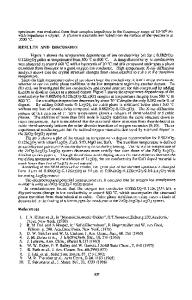Phase Transformations in ZrO 2 -SiO 2 Gels
- PDF / 351,556 Bytes
- 6 Pages / 420.48 x 639 pts Page_size
- 56 Downloads / 383 Views
PHASE TRANSFORMATIONS IN ZrO 2-SiO 2 GELS J. Campaniello*, E. M. Rabinovich**, P. Berthet*, A. Revcolevschi* andNonna A. Kopylov** *Universite de Paris-Sud, Laboratoire de Chemie des Solides, 91405 Orsay cedex, France. **AT&T Bell Laboratories, Murray Hill, NJ 07974, USA.
ABSTRACT Transparent sols and gels in the ZrO 2 -SiO 2 system containing 25, 50 and 75 mole % ZrO 2 were prepared using tetraethyl orthosilicate (TEOS) and Zr n-propoxide solution in the presence of acids. Heating the gels to 600'C yielded an amorphous product which at higher temperature crystallized with formation of tetragonal and monoclinic ZrO 2 . Zircon crystallized slowly at 1600'C. The results are explained by metastable liquid-liquid phase separation in the studied system. INTRODUCTION High-zirconia ceramics can be of a potential use as high-temperature coatings and ceramic pigments. Sol-gel routes allow relatively low-temperature preparation of these kinds of materials, and that was the reason we wanted to study phase transformations in the wide range of gel-derived materials in the binary zirconia-silica system. Nogami and Tomozawa [1] studied crystallization in a gel glass of the 3 ZrO 2 *2 Sit 2 composition and found that the tetragonal-monoclinic zirconia transformation leads to a higher fracture toughness of the material. Salvado and Navarro [2] prepared several binary compositions in the same system but their major concern was studying of gel bloating during firing. Monros et al. [3] prepared gels of the zircon ZrSiO 4 composition in which part of ZrO 2 replaced by V2 0 5 . They showed that vanadium has a decisive effect on the formation of zircon at as low as 800'C, while in the vanadium-free composition, zircon formation was not observed below 1300°C. The purpose of the present study was to examine phase transformations in materials prepared by sol-gel methods in a wider range of the binary ZrO 2 -SiO 2 system. EXPERIMENTAL PROCEDURES Three compositions containing 25, 50 and 75 mole % ZrO2 were prepared from tetraethyl orthosilicate (TEOS) and Zr n-propoxide (70% solution in n-propanol). TEOS dissolved in ethanol (1:2 molar ratio) was partially hydrolyzed with IN HCl (1:1 molar ratio of H2 O:TEOS) and kept at 60 0 C for 1 hour. This solution was slowly added to the Zr n-propoxide solution while stirring, and the resulting sol was kept at 60 0 C for 4 days. To achieve complete hydrolysis, ION HNO 3 was slowly dropped into the sol up to a final H2 0: TEOS ratio equal to 11:1. By aging the sol for several days at 60"C a transparent yellow gel expelling solvent was obtained. Following this procedure gels Zr50A (50 mole % ZrO 2 ) and Zr25A (25 mole % ZrO 2 ) were formed. Another way of achieving a complete hydrolysis was to slowly drop the intermediate sol into an excess of iN HN0 3 (H 2 0:TEOS=270:1). In this case, gelation was obtained by evaporation (gel Zr50B, 50 mole % ZrO 2 ). Gels Zr25C, Zr50C and Zr75C (25, 50 and 75 mole % ZrO 2 respectively) were similarly prepared but by substituting concentrated HC1 for HNO 3 at 5 moles wa
Data Loading...











